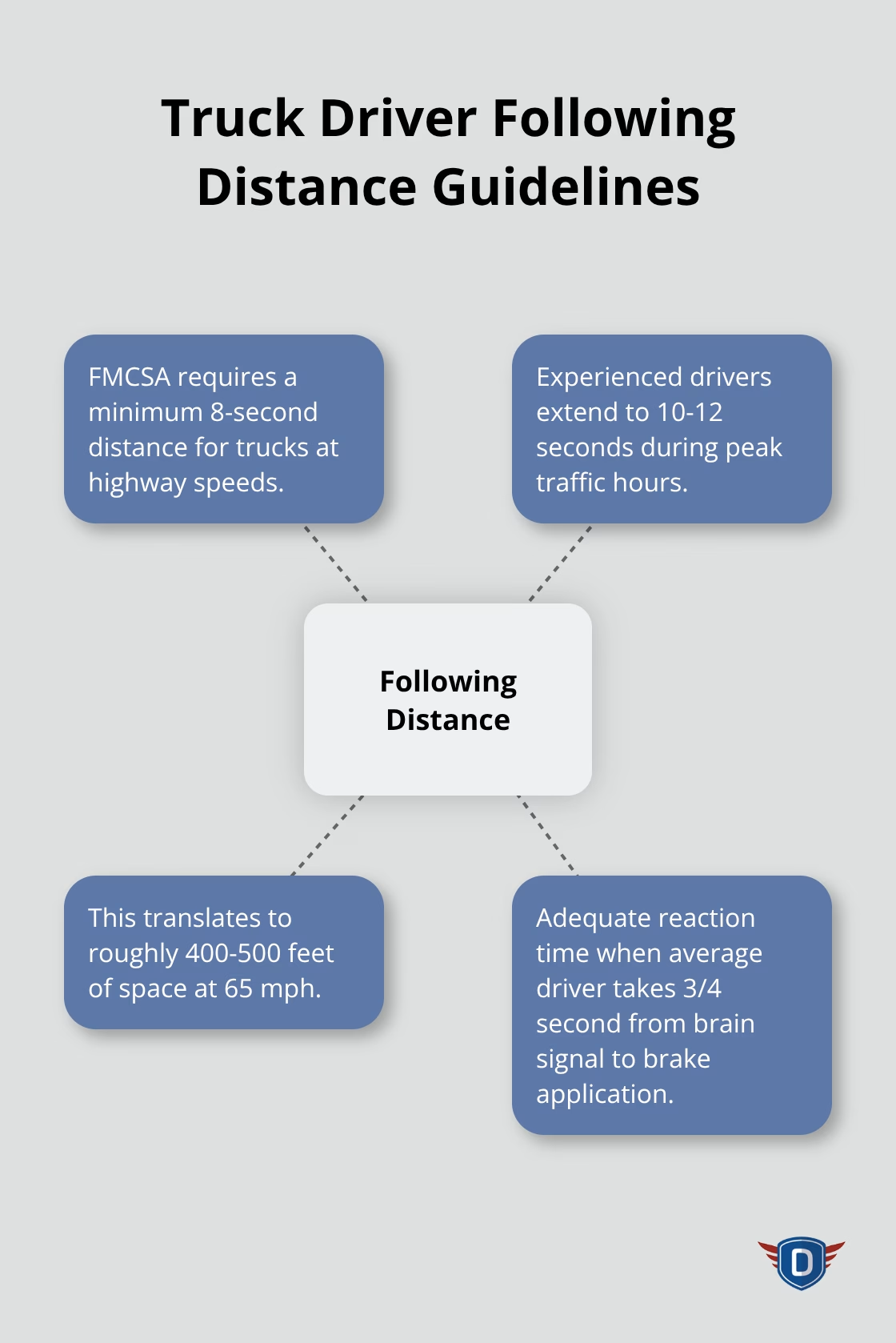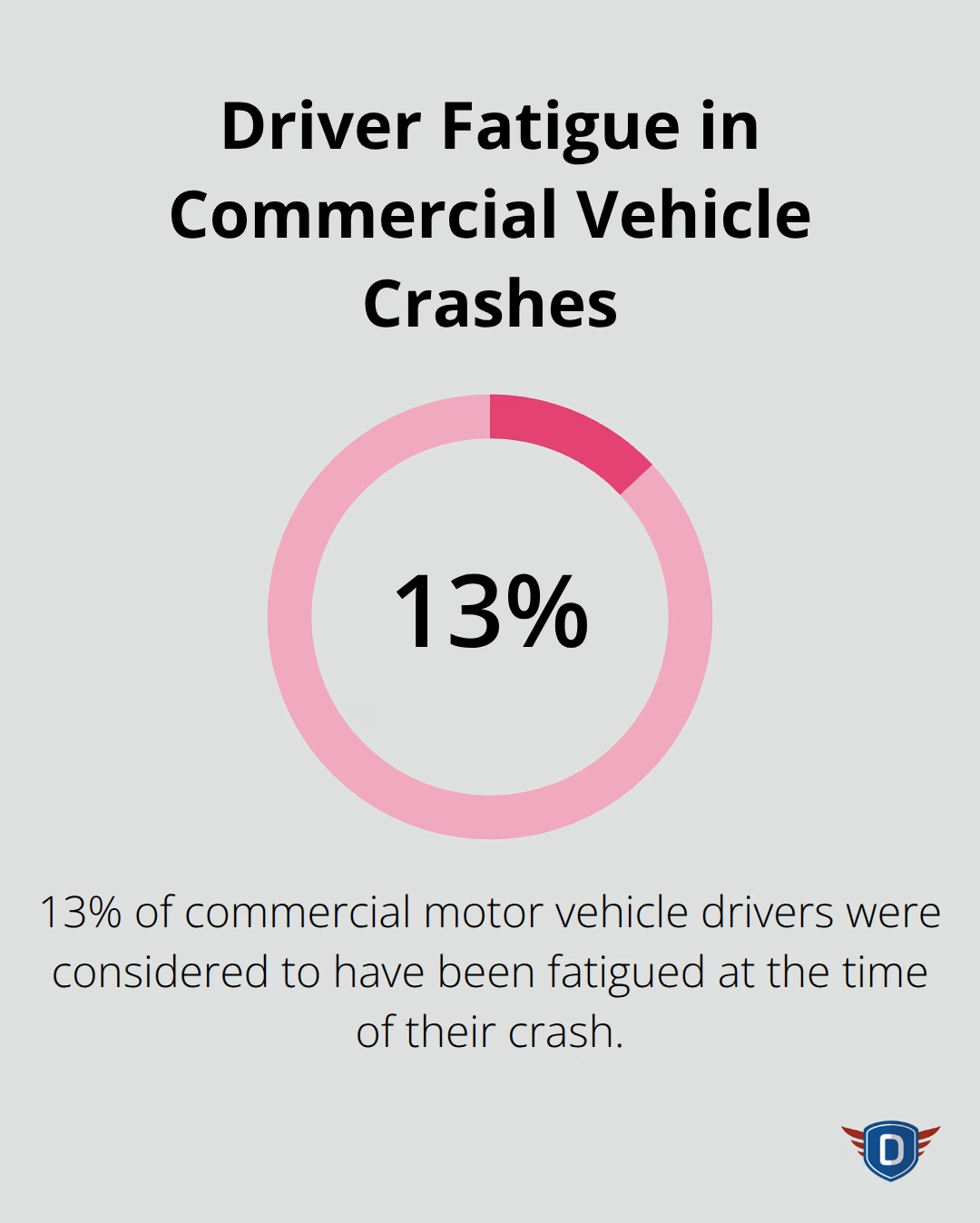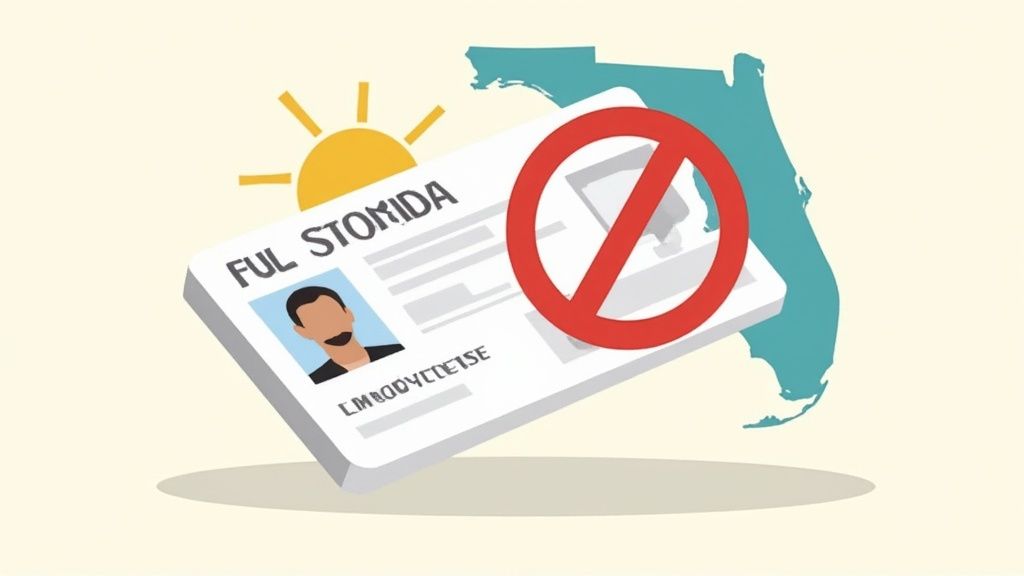Truck drivers face unique challenges on the road that require specialized defensive driving skills. Large commercial vehicles demand different safety approaches than passenger cars due to their size, weight, and stopping distances.
At DriverEducators.com, we understand that effective truck driver defensive driving training can reduce accidents by up to 40% according to Federal Motor Carrier Safety Administration data.
This guide covers proven techniques that professional drivers use to stay safe and protect other road users.

What Makes Truck Defensive Driving Different?
Defensive driving for truck drivers operates on fundamentally different principles than passenger car techniques. A fully loaded 18-wheeler weighs up to 80,000 pounds and requires the length of two football fields to stop completely, compared to a passenger car that stops in roughly 300 feet at highway speeds. This massive difference in physics means truck drivers must think and react at least 15 seconds ahead, as they scan approximately a quarter-mile down the road to identify potential hazards. The Large Truck Crash Causation Study reveals that inadequate surveillance contributes to 14% of large truck crashes, which makes constant awareness non-negotiable for professional drivers.
The Three-Second Rule Fails for Commercial Vehicles
Standard distance rules fail catastrophically for commercial vehicles. Truck drivers need one second of distance for every 10 feet of vehicle length, which means an 80-foot truck requires at least 8 seconds of distance at highway speeds. Light vehicle drivers initiate most safety-related traffic events that involve heavy vehicles, and this forces truck drivers to compensate for other drivers’ poor decisions. Professional drivers must check mirrors every 5 to 8 seconds and maintain awareness of the No-Zone areas where one-third of all truck-car crashes occur.
Unique Hazard Management for Heavy Vehicles
Truck drivers face hazards that passenger car drivers never encounter. Cargo shifts can cause rollovers or complete loss of vehicle control, which requires frequent load checks during transit. Bridge height restrictions, weight limits, and turn radius constraints create navigation challenges that standard GPS systems don’t address (commercial navigation tools become essential for route planning). Weather affects trucks differently too – crosswinds can push a high-profile vehicle into adjacent lanes, and ice forms faster on elevated roadways where trucks spend significant time.
Work Zone Dangers Multiply for Large Vehicles
Work zones present particular dangers for commercial drivers, with fatality rates that increase annually as construction activity expands across major freight corridors. Trucks need more space to maneuver around construction equipment and cannot stop as quickly when traffic patterns change suddenly. These specialized challenges require truck drivers to master advanced techniques that go far beyond basic defensive practices.
How Do Commercial Drivers Master Distance and Positioning?
Professional truck drivers must abandon standard passenger car distance rules and implement commercial-specific space techniques. The Federal Motor Carrier Safety Administration requires a minimum 8-second distance for trucks at highway speeds, but experienced drivers extend this to 10-12 seconds during peak traffic hours. This translates to roughly 400-500 feet of space at 65 mph, which provides adequate reaction time when the average driver takes 3/4 of a second from brain signal to brake application. Commercial drivers check mirrors every 5-8 seconds and position their vehicles to maximize escape routes, stay in the right lane except when they pass, and avoid the left lane during heavy traffic.
Strategic Lane Selection Reduces Crash Risk
Lane position becomes critical when 75% of lane change and merge crashes involve recognition failures by passenger vehicle drivers. Professional drivers select lanes based on traffic flow patterns rather than speed preferences, choose middle lanes on three-lane highways to avoid merging traffic and off-ramp conflicts. The No-Zone accounts for one-third of all truck-car crashes, so drivers maintain extra space when vehicles enter these blind spot areas around the cab and trailer. Smart position means drivers stay away from vehicle clusters, avoid travel alongside other trucks, and create buffer zones in all directions when possible.

Weather-Adaptive Speed Management
Speed management for commercial vehicles requires constant adjustment based on road surface conditions, visibility, and wind factors that passenger cars rarely consider. Truck drivers reduce speed by 10-15 mph below posted limits during rain and cut highway speeds to 35-45 mph during snow conditions, as stopping distances can triple on wet pavement. Crosswinds above 25 mph force drivers to reduce speed and grip the wheel firmly, while ice conditions demand speeds of 25 mph or less regardless of posted limits (professional drivers monitor weather apps continuously and adjust their speed proactively rather than reactively). Their vehicle’s high center of gravity and heavy weight create different physics than standard vehicles experience.
Mirror Management and Blind Spot Awareness
Professional drivers develop systematic mirror check patterns that passenger car drivers never master. They scan mirrors every 5-8 seconds in a specific sequence: left mirror, center mirror, right mirror, then repeat. This pattern helps them track vehicles that enter and exit their blind spots, which extend 20 feet in front of the cab, 30 feet behind the trailer, and two lanes wide on both sides. Drivers adjust their mirrors before each trip and use convex mirrors to expand their field of vision (these additional mirrors help eliminate some blind spot areas but never replace proper head checks).
These advanced position and distance techniques prepare drivers to anticipate dangerous situations before they develop into emergencies.
How Do Professional Drivers Master Predictive Safety?
Professional drivers develop pattern recognition skills that transform them from reactive to predictive operators. The Federal Motor Carrier Safety Administration data shows that large trucks and buses were involved in 5,904 fatal crashes in 2021, representing an 18-percent increase from 2020. This means commercial drivers must compensate for passenger car mistakes before they happen. Experienced drivers watch for telltale signs like erratic lane position, sudden speed changes, or drivers who appear distracted by phones. They create mental maps of every vehicle within 500 feet and track movement patterns that signal potential lane changes or sudden stops.
Smart drivers position themselves away from aggressive drivers, maintain extra distance from vehicles that show unpredictable behavior, and avoid travel alongside cars that weave or brake inconsistently.

Combat Driver Fatigue With Systematic Approaches
The Large Truck Crash Causation Study reported that 13 percent of commercial motor vehicle drivers were considered to have been fatigued at the time of their crash, yet the Federal Motor Carrier Safety Administration mandates only a 30-minute break after eight consecutive hours of drive time. Professional drivers implement stricter personal standards that include 15-minute breaks every two hours, power naps of 20-45 minutes when drowsiness begins, and complete trip stops when they experience microsleep episodes.
Smart drivers schedule their most difficult drive segments during their peak alertness hours, avoid heavy meals that cause energy crashes, and maintain consistent sleep schedules even during time off. They monitor their reaction times by tracking how quickly they respond to traffic light changes and pull over immediately when their response time slows (caffeine provides temporary alertness but never replaces proper rest).
Execute Emergency Maneuvers Without Panic
Emergency situations demand split-second decisions that untrained drivers handle poorly, but professional drivers practice specific techniques that save lives. When faced with sudden stops, experienced drivers apply steady brake pressure rather than slam brakes, which can cause jackknife situations or loss of control. They steer around obstacles only when sufficient space exists and never attempt last-second swerves that often create worse crashes.
Professional drivers identify escape routes continuously and know exactly where they can safely maneuver their vehicle if traffic stops suddenly. During tire blowouts, they maintain control of the wheel, gradually reduce speed, and avoid sudden movements that destabilize the vehicle. These practiced responses become automatic through repetition and mental rehearsal, which transforms dangerous emergencies into manageable situations that professional drivers handle with confidence.
Final Thoughts
Professional truck drivers who master defensive techniques reduce their accident risk by 40% while they protect other road users from devastating commercial vehicle crashes. These specialized skills transform reactive drivers into predictive operators who anticipate hazards before emergencies develop. Advanced defensive practices deliver measurable benefits that extend far beyond safety improvements.
Insurance premiums decrease when fleets demonstrate lower accident rates, and companies experience reduced vehicle damage costs through fewer collisions. Driver retention improves as professional operators gain confidence in their abilities to handle challenging road situations safely. Fleet managers report significant cost savings when their drivers complete comprehensive safety programs (these programs typically pay for themselves within the first year through reduced claims).
Continuous improvement requires ongoing commitment to skill development and safety awareness. Professional drivers must practice emergency maneuvers regularly and stay current with Federal Motor Carrier Safety Administration regulations. We at DriverEducators.com provide truck driver defensive driving training with certified instructors who build lifelong safe habits that protect lives on America’s highways.





